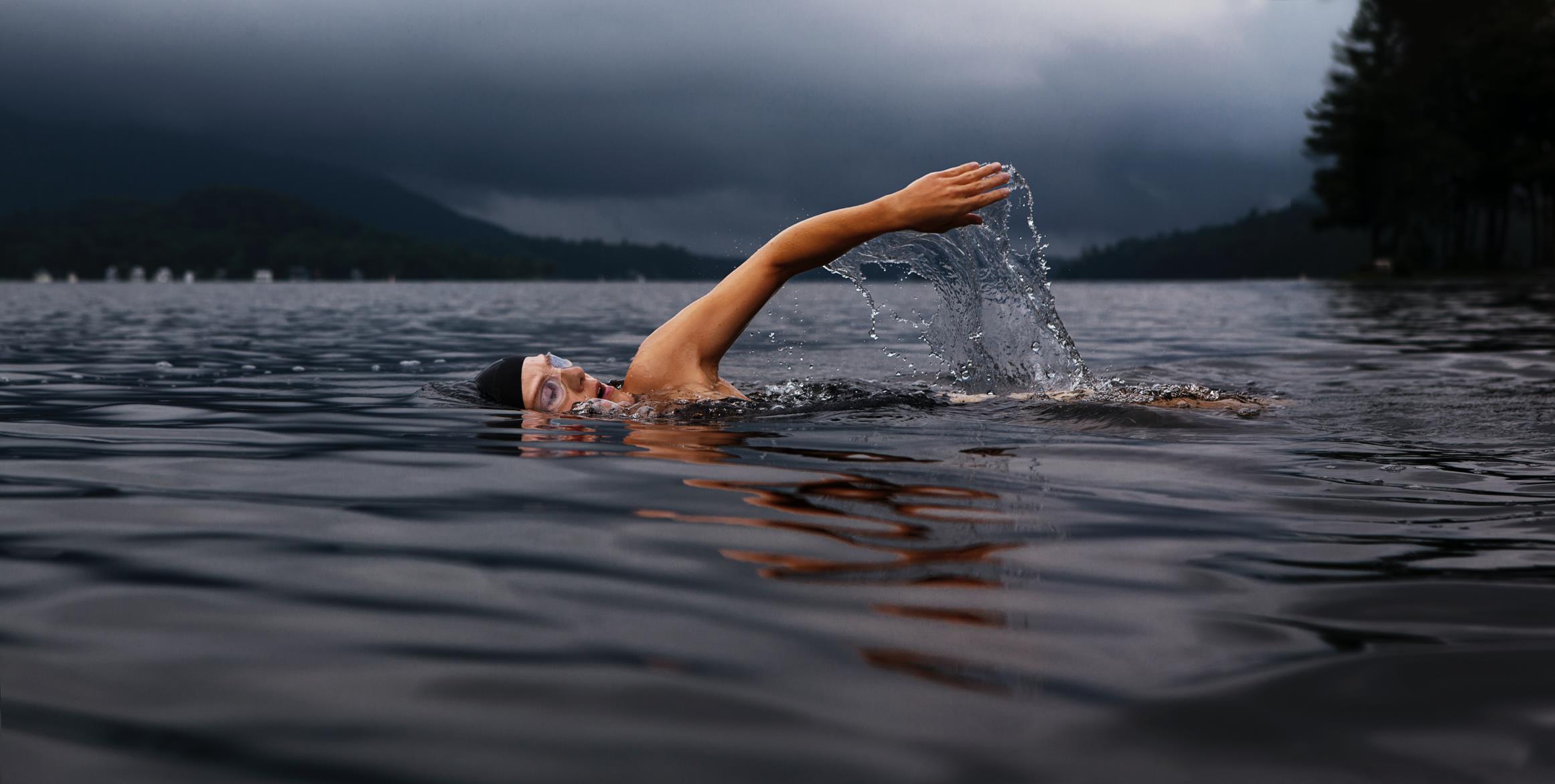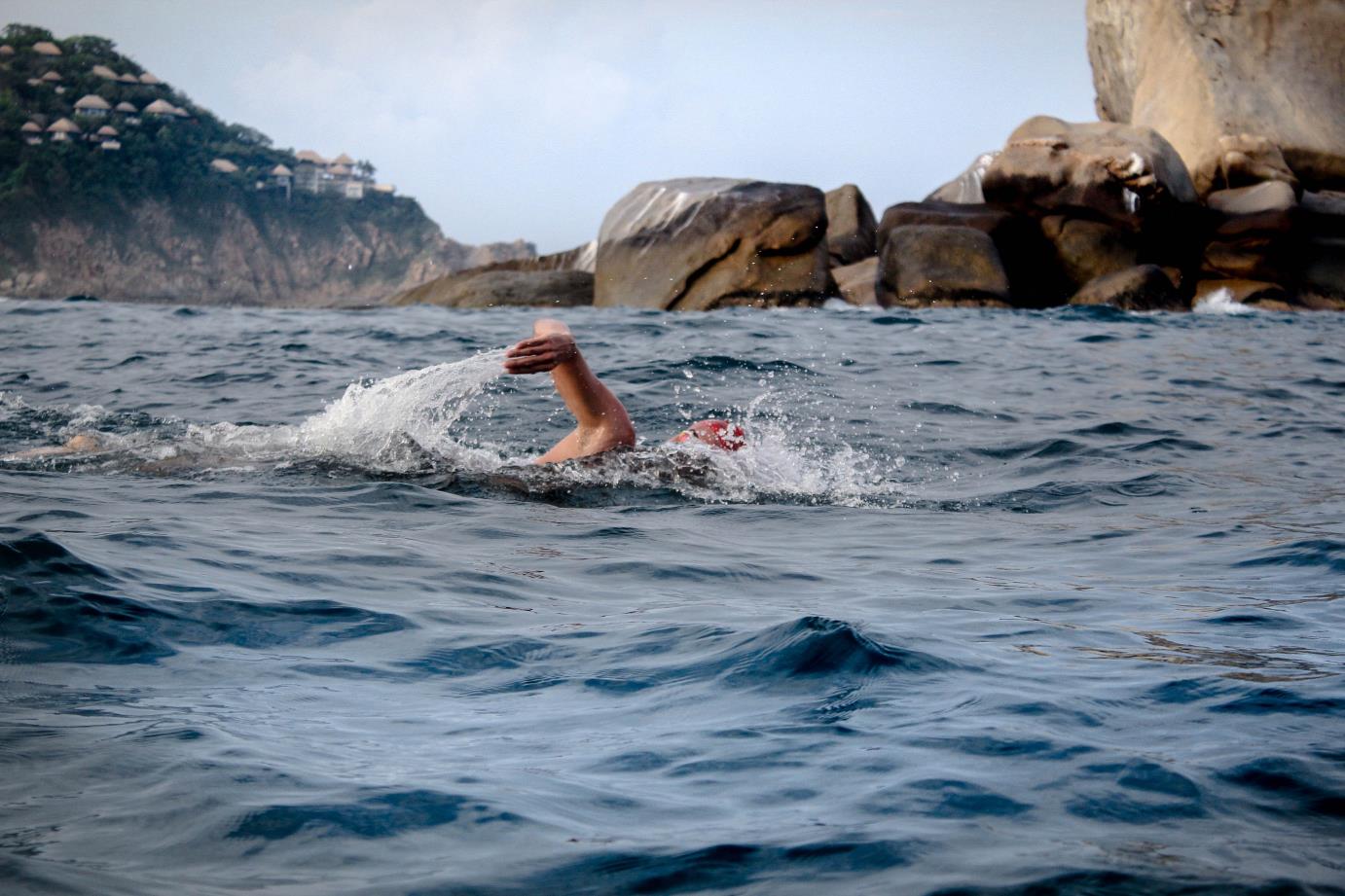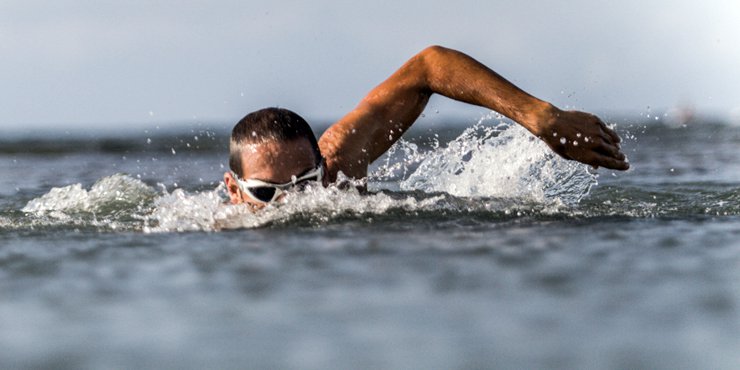Breathe Easy: Expert Tips for Improving Your Open Water Swimming and Triathlon Breathing Techniques
 Karen Parnell
January 04, 2023
Karen Parnell
January 04, 2023
Breathe Easy: Expert Tips for Improving Your Open Water Swimming and Triathlon Breathing Techniques

Open water-based triathlon and swimming races require an extra level of effort and focus. You’re battling waves, wind, currents, sun, and the flailing arms of a hundred other swimmers in a mass start. With all these added considerations, being able to breathe consistently and easily is more important than ever. But, breathing while open water swimming comes with its own set of considerations and hurdles to be overcome.
If you’ve never swum outside the lane ropes of your local pool, you might be a little surprised by how different open water swimming is. Seas and lakes can be serene and calm at times, but it can also be stormy, unpredictable, cold, salty, and wavy.
Here are some breathing tips to help you succeed during your next triathlon or open water race.
Learn to Breathe Bilaterally
Bilateral breathing—or breathing on both sides—is one skill most swimmers learn at a young age. But, as years pass, many swimmers revert to breathing to one side only. While it’s a good skill for all swimmers to feel comfortable breathing bilaterally, it’s especially beneficial for open water swimming.
In open water races, some variables will force you to breathe on both sides. You might be next to a group of swimmers on one side, so you need to turn to the other side to avoid getting splashed whenever you come up for air. In other races, boats will come by, and you will need to breathe on the opposite side to avoid inhaling a swell. Additionally, by turning to both sides to breathe, you’ll get a better sense of the racers around you.
Breathing bilaterally will also help you will a more balanced stroke and will help to keep you swim straighter. Without the lane markers beneath you may go off course more with an unbalanced stroke.
Just because it’s essential to know how to breathe to both sides doesn’t mean you need to breathe every third stroke. There’s some debate over how often long-distance swimmers should breathe, but swimmers need to find the breathing pattern that’s right for them. Maybe it’s every third stroke or second or alternating between the two—as long as you’re getting the air you need to swim comfortably and smoothly.
When I coach, I say, “breathe when you have exhaled fully and when you need to”. At the beginning of a race when you are trying to get away fast and to the front of the pack you may need to breathe every stroke. When you get into a more relaxed phase of your swim you may breathe every 2,3, 4 or even 5 strokes – whenever you need to. Near the finish of your swim, you may up your stroke rate and need to breathe more often.

Learning to breathe to both side, Bilaterally, with pay dividends on race day
Photo by Todd Quackenbush on Unsplash
Download your FREE open water swimming workouts book.
Try Hypoxic Breathing
The first 200 meters of any open water race or triathlon is always intense. The adrenaline and excitement levels are high. There will be high adrenaline levels, there will be thrashing arms, kicking legs, there will be excessive splashing, and there won’t be many opportunities to breathe. Hypoxic breathing or training is a technique to help you get used to going further on fewer breaths.
The best way to practice this is to find a section of open water that equates to around 50 meters. Swim the distance once, breathing every three strokes. Next, breathe once every five strokes. Then, every seven strokes. Eventually, try breathing once for the entire 50 meters.
Work this drill into your triathlon or open water swim training. After a bit of practice, you will be ready to handle the first few minutes of your race, even if you can’t take as many breaths as you’d like.
Failure to prepare is to prepare for failure! So, it’s always best to train for all race eventualities.

Practice Hypoxic breathing in training so you always have a Plan B
Techniques for Breathing in Choppy Water
What makes open water so unique is its unpredictability. On race day, the water could be calm, peaceful, and glass-like; it could also be windy, choppy, and have the makings of a typhoon. It’s essential to know a few techniques to help get a full breath of air, no matter which scenario you face.
Look to the sky. To remedy waves lapping into your mouth, rotate your body lead by your shoulders slightly further than you usually would during a breath and look towards the sky. You shouldn’t completely turn on your back but bring your shoulder back more and point your eyes and mouth up to make sure you inhale a good amount of air.
Breathe in quickly. Whether the water is choppy or not, it’s always a good idea not to spend too much time on your side. When the conditions are choppy, it’s even more important to take a quick breath to minimize the potential of gulping in water.
Lift your head slightly. Typically, you should always try to keep your head in line with the rest of your body. But desperate times call for clean breaths. When waves are high, lift your head slightly above the water, get a quick breath in, then return to your stroke.
While most races won’t let you swim in extreme weather, they will continue in less-than-ideal situations. These tips should help you succeed, regardless of the conditions you’re facing.

Swimming in choppy water takes practice
Photo by Alejandra Ezquerro on Unsplash
Download your FREE open water swimming workouts book.
Practice Leads to Confidence
Breathing is about technique but also about confidence. When you’re swimming in open water and take in a mouthful of water, it can be scary for swimmers at any level (especially if its salty!). When you can’t breathe, you start to panic, which can lead to hyperventilation.
Hyperventilation is rapid or deep breathing, usually caused by anxiety or panic. This overbreathing, as it is sometimes called, may leave you feeling breathless. When you breathe, you inhale oxygen and exhale carbon dioxide. Excessive breathing may lead to low levels of carbon dioxide in your blood, which causes many of the symptoms that you may feel if you hyperventilate.
Hyperventilation can stop even the most confident open water swimmer and force them to tread water, change to breaststroke or even pull out from a race. That’s why an essential way to get used to breathing in open water is to practice.
Most open water is often a lot colder than your average pool, so you need to get your body used to the water before you start swimming. During your first few sessions in a lake or ocean, start by submerging your body entirely in a shallow area and splashing your face. This is also an excellent time to test out your wetsuit. Wetsuits can be restricting on your diaphragm and around your chest, so it’s best to get a feel for what it’s like to breathe with one on in colder temperatures.
Start by swimming a few hundred meters in a shallow area. Be careful not to breathe too much or too quickly; this can cause an imbalance of oxygen molecules in your lungs and lead to dizziness.
If you ever find yourself hyperventilating during a race or workout, try slowing down and breathing every four or five strokes. It might seem counterintuitive to breathe less, but it helps you get your breathing back on track. At this point changing to breaststroke can help to get your breath under controls whilst still going forward.

Relax, Breaststroke and get your breathing rhythm back
Download your FREE open water swimming workouts book.
Sighting to Keep Swimming Straight
As mentioned earlier you don’t have pool lane ropes or a big black line under you to follow so you may not swim straight. You can test how straight you swim in open water by swimming in a safe open water location for 20 strokes with your eyes closed. Where did you end up? Left, right or straight? This will show your stronger side and why sighting regularly is important.
Sighting is the looking up from your stroke to identify your surroundings and guide the direction you are swimming in. It identifies hazards and keeps you on your swim path. Being good at sighting stops zig zagging, giving you a competitive advantage in races. Swimming straight can save you hundreds of metres of swimming in a long race!
You may consider just following other swimmers but if they are not good at sighting, they could take you off course. Going straight is your responsibility.
There are generally two approaches to sighting: either lift your whole head out of the water when looking ahead or to just lift your eyes above the surface of the water (like a crocodile) then turn to breath to the side like normal. Both are considered fine to use in your swimming, so experiment with what feels most comfortable and natural to you.
If you lift your head up a lot your hips will drop and slow you down so if you are going for time then practice the “crocodile sighting”. If you don’t spot the buoy or landmark, you are looking for don’t be tempted to lift your head higher and slow down just take another crocodile sighting on the next stroke.
If it’s choppy then a full head up and breath may be appropriate. The more you swim in open water the more you will be able to choose the strokes and techniques to suit the conditions. Perfect practice makes perfect!

Crocodiles Eyes Sighting to keep you body aligned in the water
Image: Ironman
Download your FREE open water swimming workouts book.
Simulating Open Water Conditions in the Pool
It’s strongly advised to get as much open water swimming practice in before your race day – especially in conditions like those you will encounter during your event. But if you are restricted to only pool training before your race, consider mimicking open water race conditions. Grab a couple of friends, and line up two or three abreast and two deep. When you practice swimming in close quarters with other swimmers, the water will be choppy, just like open water. If you’re able to, another option is to remove lane lines and drop an empty gallon jug (attached to a weight) in the pool under the flags. You can practice racing your friends to the jug and turning around it as if it’s a buoy. Practice races starts without pushing off the swimming pool walls. Try a whole session sighting every 3 or 5 strokes and don’t use the walls to push off.
I find using my Endless pool is a good open water simulator as you need to sight on the Endless pool fan to keep in the optimum flow plus it does create some waves to wrestle with.
Endless Pool at ChiliTri in Southern Spain
Conclusion: Imrpove you Open Water Swimming Skills
You might be confident about breathing in the pool but breathing in open water has its challenges. By practicing these skills, you’ll be able to power on during workouts and races, even when the water conditions are less than ideal.
If you would like to build your confidence in open water then one of our swimming clinics in Spain could be ideal for you.
Download your FREE open water swimming workouts book.
Swimming and Triathlon Training plans on TrainingPeaks.
Swimming and Triathlon Training plans on FinalSurge.
If you have any questions get in touch – karen.parnell@chilitri.com
Karen Parnell is a Level 3 British Triathlon and IRONMAN Certified Coach, 8020 Endurance Certified Coach, WOWSA Level 3 open water swimming coach and NASM Personal Trainer and Sports Technology Writer.
Karen is currently studying for an MSc in Sports Performance Coaching at the University of Stirling.
Need a training plan? I have plans on TrainingPeaks and FinalSurge:
I also coach a very small number of athletes one to one for all triathlon and multi-sport distances, open water swimming events and running races, email me for details and availability. Karen.parnell@chilitri.com
Get your FREE Guide to Running Speed and Technique
Get your FREE Swim Workouts for Triathletes E-book
Get your FREE Open Water Swimming Sessions E-Book
FAQ Breathing while swimming in open water
Should I breathe on both sides when swimming?
Breathing on both sides of your body while you are swimming creates smooth, even strokes. You get a better balance in the water by alternating your breathing and you develop uniform muscles. Breathing to both sides of your body becomes even more important when you move from the pool to the open water.
Why do I get so out of breath swimming?
Your breathing urges are driven by excessive CO2, not by a lack of oxygen. Getting rid of the CO2 helps relieve the out-of-breath distress. Swimmers who don't exhale properly will quickly feel winded because of this reflex, even though they probably aren't really suffering oxygen debt.
Is open water swimming harder than a pool?
The body generally works harder in open water due to it being colder than the pool. You usually cannot stand up in the middle of a lake or sea so you have to keep moving, whereas you can in the pool.
Is Open Water Swimming healthy?
Open water swimming is riding the crest of a wave in popularity, and for good reason. Studies show it can help with depression, weight loss, boosting your immune system, increasing your fitness and muscle strength, and adding to overall happiness.
What is a bilateral breathing pattern?
A bilateral breathing pattern simply means breathing to both sides while swimming freestyle. The most common bilateral breathing patterns for freestyle swimmers are to either take a breath every three or five strokes.
What is sighting?
Sighting is the looking up from your stroke to identify your surroundings and guide the direction you are swimming in. It identifies hazards and keeps you on your swim path. Being good at sighting stops zig zagging, giving you a competitive advantage in races.
What is crocodile eyes sighting in open water swimming?
The most popular technique for sighting is Crocodile eye sighting. When you first catch the water, reaching forward with one hand, push down on the surface to create stability and lift your eyes just above the water's surface to sight.
What is hypoxic swim training?
Within the world of competitive swimming, hypoxic training is a technique used by swimmers to improve their tolerance within the water when confronted with a deficit of oxygen. This is achieved by methodically limiting breathing during training sessions.
Download your FREE open water swimming workouts book.
References
HOW TO SIGHT – Outdoor Swimming Society Outdoor Swimming Society
Hyperventilation | Johns Hopkins Medicine
Open Water Swimming – FORM (formswim.com)
Sight Like an Alligator, Swim Like a Fish (ironman.com)
#traithlontrainingplans #runningtrainingplans #swimmingtrainingplans #triathlon #swimming #swimbikerun #openwaterswimming
